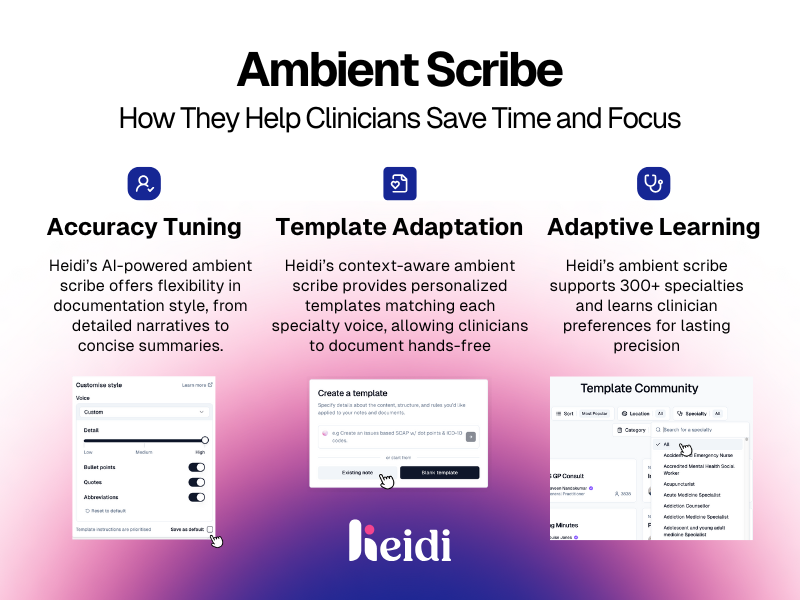Ambient Scribe: Technology Guide for Clinicians

What is an Ambient Scribe?
Ambient scribes, or AI medical scribes, are documentation tools that utilize AI-powered technology, such as ambient voice and listening, to assist clinicians in capturing patient information and automating their workflows.
A small gesture like eye contact can make a significant difference for patients. The use of ambient digital medical scribes helps restore this by making documentation smarter, more efficient, and more streamlined. So, how do practitioners respond to the ceaseless necessity of human connection during patient encounters?
In this blog, we’ll discuss how useful ambient scribes are in medical practice, particularly how they save time, help clinicians regain focus, and support the healthcare system in general.

How Ambient Scribes Help Clinicians Save Time and Focus
In recent years, the impact and utility of ambient intelligence tools have grown in variety and depth. Further, the plethora of ways that ambient scribes help clinicians maintain focus and save time is not limited only to clinics and hospitals. Ambient scribes hold immense promise, not only supporting clinician well-being but also extending benefits to patients and agencies.
While administrative tasks have been cited as a contributor to physician burnout, recent years have shown a downward trend in job stress. Ambient scribe providers have undoubtedly played a role in this improvement. The long-term objective to support the growth of job satisfaction among clinicians is clear, although understated.
Ambient Scribes in Different Settings
Ambient scribing has given clinicians back up to 3 hours daily, so patient capacity is boosted as wrap-up times are reduced. With minimized screen time, patient-clinician interaction is improved, which has led to the adoption of ambient scribes in various care settings.
- Hospitals - Clinician well-being, workforce sustainability, and the reduction of EMR burden are the main focus of ambient scribes in hospitals. Ambient scribes offload documentation, thus reducing the after-hours charting stress, which is a major cause of burnout. Hospitals continue to lose mid- to late-career clinicians, and ambient scribes help combat EMR-induced attrition by making documentation less intrusive.
- Home health - Ambient scribes complete documentation for clinicians while patient context is still fresh. They eliminate batch reporting by the end of day, and this improves consultation recall and accuracy.
- Agencies - Ambient scribes help agencies recover precision on revenue cycles and reimbursements. Outpatient and home health agencies depend on prompt documentation for efficient billing. With better documentation, agencies yield higher quality audits, fewer denied claims, and reduced resubmissions.
One ambient scribe can simultaneously support an entire team. The flexibility of ambient scribes for multi-provider clinics enables larger capacity and delivers a positive impact to patients.
This is why the team under the supervision of Dr. Olga Lavalle underwent workflow efficiency improvement after Heidi: “Heidi was evolving to be something not just for doctors but for clinical psychologists. When I was giving feedback, they were listening - that's why I've stuck with Heidi,” she quips.
"The clients have all agreed to allow me to use it," Dr. Lavalle reports. "They're giving feedback about how good it is that I don't have to take notes in session. It's changed the therapeutic relationship."
How Does Ambient Scribe Technology Support Healthcare?
Ambient scribe technology has made documentation smarter, and certain essential features have made this possible. Ambient listening functions alone don’t suffice; they need other capabilities that allow them to enable structured documentation. Automation, therefore, only works when these AI layers are unified.
But in healthcare, what makes documentation smarter?
Smarter Documentation with Ambient Scribes
- Clinical style matching - Ambient scribes don’t simply transcribe words; they tailor EHR-ready clinical notes, matching specialty-relevant terminology that provides proper context to be structured.
- Automatic detection of notes - The AI system distinguishes between clinical information and background noise, so clinicians can skip the excessive sifting aspect of the documentation process.
- Specialty context-awareness - Smart ambient scribes typically adapt their notes to reflect structured information based on certain disciplines.
What Makes Heidi’s Ambient Scribe Stand Out
Ambient scribes are AI-enabled to maximize their impact and benefits in healthcare. Even better, ambient scribes never call in sick or create bottlenecks in clinical workflows. They merely coordinate ambient listening tech to allow a more seamless documentation for clinicians.
However, Heidi’s ambient scribe stands out among the rest.
- Accuracy tuning: Heidi provides options, like AI models that offer subtle variations in documentation style to match different clinical approaches. The clinician is given the freedom to attune notes, from elaborate narratives to concise wording, to keep the note quality and accuracy intact.
- Template adaptation - Heidi’s context-aware ambient scribe offers personalized templates that adapt to any practice’s style, voice, and requirements for documentation. There’s no need to encode; clinicians can do a few clicks and get on with more critical tasks.
- Adaptive learning based on clinician edits - Unlike specialty-restricted solutions, Heidi's ambient scribe is inherently flexible across different clinical specialties while continuously adapting to clinician needs. Heidi’s AI medical scribe supports over 300 medical specialties with contextual prompting. It also remembers modifications for formatting, terms, or structure (e.g., changing "PX" to "physical reason") to show what has been learned.
How To Use an Ambient Digital Scribe in Your Clinical Practice
By now, we have learned a lot about how the typical ambient AI medical scribe works. We also recognize that they are a product of AI technologies such as ambient voice and ambient listening. But, we need to delve into the end-to-end AI scribing process: where it enters, acts, and exits from the process of patient intake down to the note sign-off.
In this section, we’ll take a look at ambient scribes in action, where Dr. Charles Kuntz, a veterinary specialist surgeon, shares his experience with Heidi.
Step 1: Pre-Implementation Setup
Certain things should be in order before using an ambient scribe in your practice. You need to assess your readiness, your infrastructure, and forms to obtain patient consent. You can start by evaluating your technological proficiency and patient volume to be able to scale the data to be handled by the ambient scribe.
More often than not, a real-time ambient scribe doesn’t require a lengthy process to be set up. All you need is to allow a microphone from a browser or desktop app to ensure that the equipment captures audio properly.
In this short clip, we see Dr. Kuntz enjoying the extra time Heidi allows him, as he no longer has to handle the complexities of documentation.
Step 2: The Clinical Encounter
When you start the ambient recording, you can simply turn on the microphone in your ambient scribe application at the start of each visit. You can then proceed with conducting the usual patient conversation. The ambient scribe runs in the background, listening to spoken dialogue, then filtering the unnecessary chatter from the crucial medical information.
It should be noted that clinical discretion is always exercised when using ambient scribes. They may not be suitable for all patient groups, such as children or individuals with cognitive impairments. An added benefit of ambient scribes is customization; the fact that you can add notes mid-consultation or insert clinical observations as it happens.
You can see how ambient scribes exactly help you this way, through this testimonial from Dr. Kuntz, who considers Heidi as a game-changer in his daily workflow.
Step 3: Post-Consultation Documentation
As a clinician, interacting with patients is undoubtedly the highlight of your day. However, the true relief comes from seeing your notes accurately documented, leaving you with only the final touches. Ambient scribes complete your notes for you, yet you have the full control and freedom to evaluate their effectiveness.
As ambient scribes like Heidi integrate seamlessly into EHRs, improvement in practice efficiency can be measured. This is another extra benefit from using ambient scribe automation. Data such as documentation duration, user satisfaction, and clinician fulfillment can all contribute to enhancing the overarching healthcare system.
An AI-powered clinical scribe system saves you time, money, and energy; all of which are resources that might be ample, but are irretrievable once spent. This is exactly why ambient scribe providers like Heidi built a compliant AI scribe that diminishes up to 40% of documentation time.
Why Heidi Ambient Scribe is the Right Fit for Healthcare Providers
A single-function clinical AI product wouldn’t be able to keep up with innovations in the long term. Heidi’s multi-layered ambient scribe technology responds to this increasing demand for clinician help by ensuring that it accommodates all specialties without losing note quality.
Heidi’s ambient scribe not only automates your documentation workflow, but it also:
- Adapts to you, not the other way around: Heidi supports clinicians of any specialty, and it adapts to your voice, style, and preferences in documentation.
- Goes beyond scribe functions: Your single note can serve as a basis for any document you might need: referrals, summaries, even follow-up tasks for specialists.
- Fosters clinician-patient trust: Heidi achieves 60-80% activation rates because clinicians use it. Patients also feel more comfortable and better cared for.
Heidi enables over 2 million patient consultations every week, delivering region-ready compliance and enterprise-grade data localization across Australia, Canada, the US, the UK, and more.
Frequently Asked Questions about Ambient Medical Scribes
What does ambient scribe mean in healthcare?
Ambient scribe in healthcare is becoming the AI backbone of the clinical encounter. Huge chunks of time for documentation are scraped by these ambient tools, so clinicians avoid feeling excessive stress from admin burden. From a broader perspective, ambient scribe in healthcare means more time to deliver high-quality care to patients and happier clinicians.
What is the best ambient scribe?
The best ambient scribe offers a high-quality, robust clinical tool that streamlines documentation for clinicians. It allows clinicians workflow flexibility, accessibility, and customization options. While most ambient scribe companies provide unclear pricing points and free trial plans, Heidi offers a free version with the most essential AI scribe features.
Are ambient scribes worth it?
Yes. Ambient scribes offer valuable support across various healthcare settings, including primary care and areas with limited connectivity. They are beneficial for clinicians of all disciplines and are even anticipated to assist medical students in their studies.
.webp)
Know more. Feel clever.
No-nonsense goodies about the latest in MedTech from your friends at Heidi.
Meet your AI resident.
It’s like you, but less gorgeous.
.svg)

.svg)
.svg.webp)
















%201.png)

.svg)






